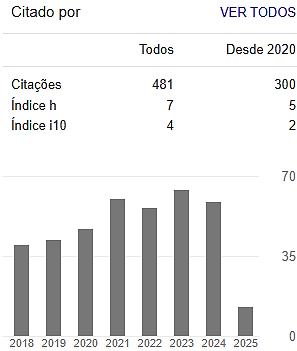AUTOMATED CORRECTION OF ESSAY QUESTIONS USING SIMILARITY MEASURES AND NATURAL LANGUAGE PROCESSING
DOI:
https://doi.org/10.5747/ce.2023.v15.e399Keywords:
NPL, automatic evaluation, essay questionsAbstract
Brazil has experienced in the last decade, a great increase in demand for Distance Learning, with the advent of the pandemic, this trend was even more accentuated with the adaptation forced by the pandemic reality to teachers, although difficult initially, contributed to a clear vision of how technological tools can provide greater assistance in the practice of their pedagogical and teaching activities to students, helping and preventing incorrect assessments during a period of physical or emotional stress, while optimizing the time dedicated to their professional activity. Using Natural Language Processing techniques to obtain the representation of knowledge from the student's pre-processed response, it was possible to obtain an accuracy between 50 and 77 per cent when compared to the grade assigned by a human evaluator and the computational system itself, simply by the evaluator providing the system a reference answer or a set of keywords or several samples of each question of what is expected to be covered within the evaluated answer.
Downloads
References
ALBAWI, S.; MOHAMMED, T. A.; AL-ZAWI, S. Understanding of a convolutional neural network. In: INTERNATIONALCONFERENCE ON ENGINEERING AND TECHNOLOGY (ICET). 2017. https://doi.org/10.1109/ICEngTechnol.2017.8308186.
ALI, Z. A simple Word2vec tutorial Medium, 7 jan. 2019. Disponível em: https://medium.com/@zafaralibagh6/a-simple-word2vec-tutorial-61e64e38a6a1. Acesso em: 24 abr. 2022.
BRYANT, C.; BRISCOE, T. Language model based grammatical error correction without annotated training data. In: WORKSHOP ON INNOVATIVE USE OF NLP FOR BUILDING EDUCATIONAL APPLICATIONS. 13., 2018. New Orleans, Louisiana. Proceedings [...]. New Orleans: Association for Computational Linguistics,2018. p. 247-253. https://doi.org/10.18653/v1/W18-0529
CARVALHO, M. J. S.; NEVADO, R. A.; MENEZES, C. S. Arquiteturas pedagógicas para educação à distância: concepções e suporte telemático. In: SIMPÓSIO BRASILEIRO DE INFORMÁTICA NA EDUCAÇÃO-SBIE, 16., 2005, Juiz de Fora. Anais [...]. Juiz de Fora, 2005. p. 351-360.
COHEN, D. Precalculus: A Problems-Oriented Approach , Cengage Learning,2004.
COSTA, L.; OLIVEIRA, E. H T.; CASTRO JÚNIOR, A. Corretor Automático de Redações em Língua Portuguesa: um mapeamento sistemático de literatura. In: SIMPÓSIO BRASILEIRO DE INFORMÁTICA NA EDUCAÇÃO, 31., 2020. Porto Alegre, Anais [...]. Porto Alegre: Sociedade Brasileira de Computação, 2020. p. 1403-1412. DOI: https://doi.org/10.5753/cbie.sbie.2020.1403.
NIST. COSINE DISTANCE, COSINE SIMILARITY, ANGULAR COSINE DISTANCE, ANGULAR COSINE SIMILARITY, 2017. Disponível em: https://www.itl.nist.gov/div898/software/dataplot/refman2/auxillar/cosdist.htm. Acesso em: 17 abr. 2022.
DERTAT, A. Applied Deep Learning - Part 4: Convolutional Neural Networks. Towards Data Science, nov. 2017. Disponível em: https://towardsdatascience.com/applied-deep-learning-part-4-convolutional-neural-networks-584bc134c1e2. Acesso em: 11 dez. 2022.
FEPESP. Hora-atividade. São Paulo: FEPESP, 2018. Disponível em: http://fepesp.org.br/noticia/hora-atividade/. Acesso em: 10 out. 2021.
HU, Y.; JING, X.; KO, Y.; RAYZ, J. T. Misspelling Correction with Pre-trained Contextual Language Model. In: INTERNATIONAL CONFERENCE ON COGNITIVE INFORMATICS & COGNITIVE COMPUTING (ICCI* CC). 19., IEEE, 2020. p. 144-149. https://doi.org/10.1109/ICCICC50026.2020.9450253
JONES, K. S. A statistical interpretation of term specificity and its application in retrieval. Journal of documentation, 1972.
LANDAUER, T.; LAHAM, D.; FOLTZ, P. Learning human-like knowledge by singular value decomposition: A progress report. In: CONFERENCE ON ADVANCES IN NEURAL INFORMATION PROCESSING. NIPS’97. 1997. Proceedings [...]. 1997, v. 10. Disponível em: chrome-extension://efaidnbmnnnibpcajpcglclefindmkaj/https://proceedings.neurips.cc/paper_files/paper/1997/file/cec6f62cfb44b1be110b7bf70c8362d8-Paper.pdf. Acesso em: 30 jun. 2023.
LÓPEZ-HERNÁNDEZ, J., ALMELA, Á., VALENCIA-GARCÍA, R. Automatic Spelling Detection and Correction in the Medical Domain: A Systematic Literature Review. In: VALENCIA-GARCÍA, R. et al. (eds.) Technologies and Innovation. CITI 2019. Communications in Computer and Information Science. [S.l.]: Springer, Cham, 2019, v.1124. https://doi.org/10.1007/978-3-030-34989-9_8
MIKOLOV, T. et al. Efficient Estimation of Word Representations in Vector Space. arXiv:1301.3781 [cs], 6 set. 2013.
NAU, J.; HAENDCHEN FILHO, Aluizio; DAZZI, R. L. S. Identificação e avaliação automática da proposta de intervenção em textos dissertativos-argumentativos: uma revisão sistemática da literatura. In: COMPUTER ON THE BEACH, 10., 2019, Itajaí. Anais [...]. Itajaí, 2019. p. 493-501.
OMELIANCHUK, K.; ATRASEVYCH, V.; ARTEM, C.; SKURZHANSKYI, O. GECToR--Grammatical Error Correction: Tag, Not Rewrite. arXiv preprint arXiv:2005.12592, 2020. https://doi.org/10.18653/v1/2020.bea-1.16
PARISI, J. M. A remuneração da hora-atividade e dos períodos de janela na jornada de trabalho do docente. Trabalho de Conclusão de Curso (Graduação) - Faculdade de Direito, Universidade Federal do Rio Grande do Sul, Porto Alegre, 2017.
RAJARAMAN, A.; ULLMAN, J. D. Mining of massive datasets. [S.l.]: Cambridge University Press, 2011. https://doi.org/10.1017/CBO9781139058452
SANTOS, J. C. A. et al. Avaliação automática de questões discursivas usando LSA. 2016. Tese (Doutorado em Engenharia Elétrica) - Instituto de Tecnologia, Universidade Federal do Pará, Belém, 2016.Disponível em: http://repositorio.ufpa.br/jspui/handle/2011/7485. Acesso em: 30 jun. 2023.
SMITH, K. J. Precalculus: A functional approach to graphing and problem solving. [S. l.]: Jones & Bartlett Publishers, 2011.
SINGHAL, A. et al. Modern information retrieval: A brief overview. IEEE Data Eng. Bull., v. 24, n. 4, p. 35-43, 2001.
SIROTHEAU, S.; SANTOS, J.; FAVERO, E.; FREITAS, S. N. Avaliação Automática de respostas discursivas curtas baseado em três dimensões linguísticas. In:
CONGRESSO BRASILEIRO DE INFORMÁTICA NA EDUCAÇÃO, 8., SIMPÓSIO BRASILEIRO DE INFORMÁTICA NA EDUCAÇÃO, 30., 2019, Brasília. Anais [...]. Brasília: 2019. https://doi.org/10.5753/cbie.sbie.2019.1551
WIEMER-HASTINGS, P. Latent semantic analysis. In: INTERNATIONAL JOINT CONFERENCE ON ARTIFICIAL INTELLIGENCE. 16., 2004. Proceedings [..], 2004, p. 1-14.
VICARI, R. M. Tendências em inteligência artificial na educação no período de 2017 a 2030: sumário executivo. Porto Alegre: SENAI/RS, 2018.

